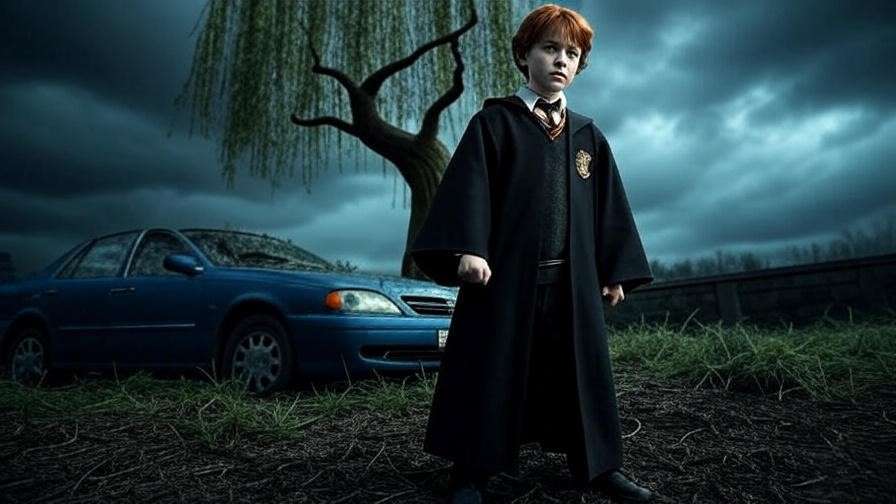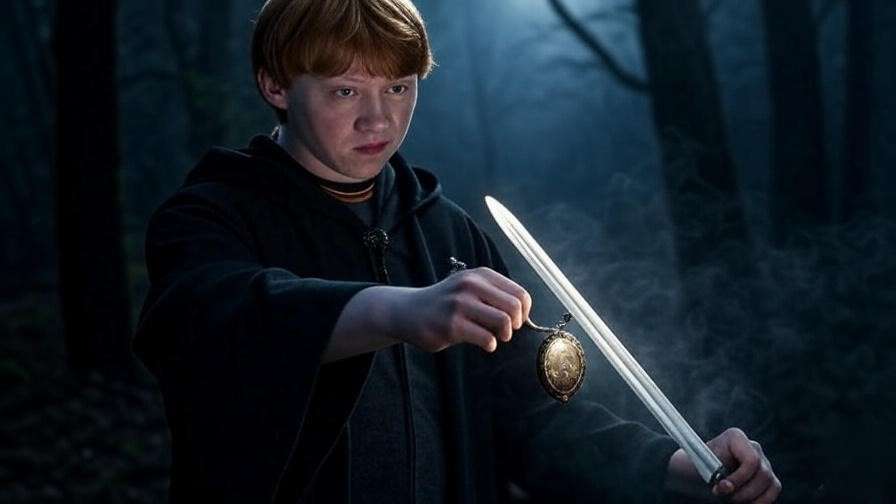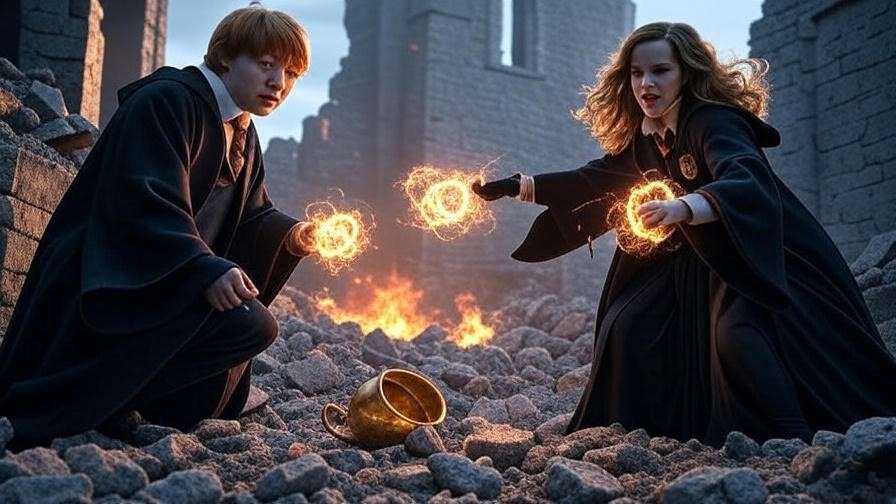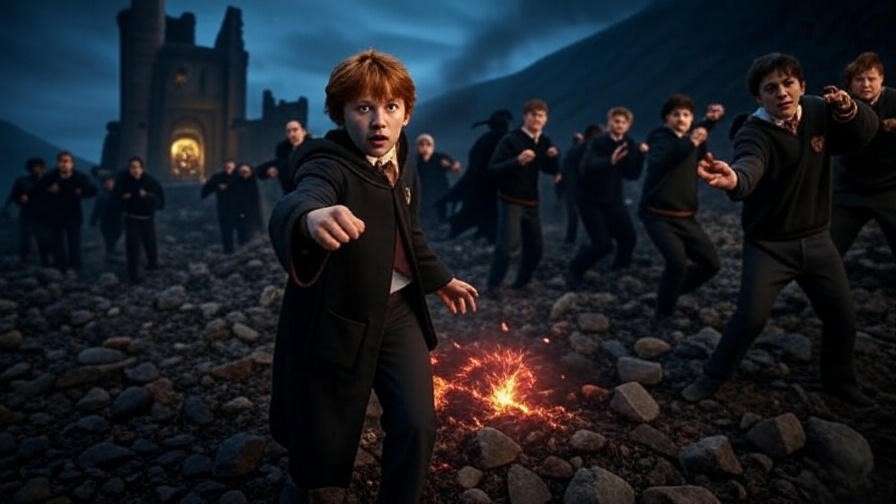Picture Ron Weasley, the loyal sidekick, standing tall against a chessboard giant in Harry Potter and the Philosopher’s Stone—a moment that unveils the courage of Ron Weasley in a way that rivals his more celebrated friends. Often overshadowed by Harry and Hermione, Ron’s bravery shines through acts of loyalty, resilience, and personal growth across the series, captivating fans on [Harry Potter Related Blog]. This article explores his most courageous moments, from the chessboard sacrifice to the Battle of Hogwarts, offering readers practical lessons to overcome self-doubt and stand by others—a need many face in today’s world.
The Roots of Ron’s Courage
Overcoming Insecurity in a Large Family
Ron Weasley’s courage begins with his struggle to stand out in a family of seven children. Growing up with hand-me-down robes and a secondhand wand, he battles insecurity daily, yet his decision to try out for the Gryffindor Quidditch team in Philosopher’s Stone showcases early bravery. J.K. Rowling, in a 2000 interview with Scholastic, designed Ron as the “everyman,” reflecting the courage it takes to rise above perceived inadequacy. For readers exploring “Ron Weasley early courage,” this moment highlights how self-belief can emerge from humble beginnings, a lesson for anyone feeling overshadowed.
This foundation of overcoming insecurity lays the groundwork for Ron’s later acts. His willingness to join Harry on adventures, despite lacking the spotlight, reflects a quiet courage that resonates with those navigating family dynamics or workplace hierarchies.
Early Acts of Bravery at Hogwarts
Ron’s bravery emerges early at Hogwarts, most notably when he follows Harry into a girls’ bathroom to face a troll in Philosopher’s Stone. Armed with a broken wand and limited skill, he stands by his friend, risking injury to protect Hermione. Rowling, in a 2003 fan chat, noted this as a “defining act of loyalty,” emphasizing Ron’s willingness to act despite fear. This moment, a cornerstone of “Ron Weasley brave moments,” teaches readers that courage can stem from friendship, offering a strategy for supporting peers in challenging situations.
Another early instance is his role in the Forbidden Forest detention, where he faces spiders despite his arachnophobia. This act, though reluctant, shows his commitment to the group, providing a relatable model for confronting personal fears.
Courage in the Face of Danger
The Chessboard Sacrifice
One of Ron’s most iconic displays of the courage of Ron Weasley occurs during the underground chess game in Philosopher’s Stone. As the group nears the Sorcerer’s Stone, Ron takes the role of a knight, sacrificing himself by allowing the queen to knock him out, ensuring Harry can proceed. This strategic self-sacrifice, executed with a calm mind at age 11, showcases intellect and bravery. Rowling, in a 2005 interview, called it “Ron’s chess move [that] saved them all,” underscoring its significance.

For readers interested in “Ron Weasley chessboard courage,” this moment offers a lesson in prioritizing team success over personal safety—a principle applicable to sports, work projects, or family decisions. It’s a testament to how courage can manifest through calculated risk.
Confronting the Whomping Willow
In Harry Potter and the Chamber of Secrets, Ron’s courage shines when he drives the Ford Anglia into the Whomping Willow to protect Harry. With a broken wand sparking unpredictably, he faces the tree’s violent branches, prioritizing his friend’s safety over his own. Rowling, in a 2002 Bloomsbury event, highlighted this as “Ron’s instinctual bravery,” driven by loyalty rather than skill. This incident, part of “Ron Weasley courageous acts,” illustrates how courage can emerge in chaotic, unplanned moments, offering readers a guide for quick decision-making under pressure.

The aftermath—repairing the car and facing his parents’ wrath—further shows his resilience, a trait readers can apply when dealing with the consequences of bold actions.
The Triwizard Tournament Support
Ron’s courage evolves in Harry Potter and the Goblet of Fire during the Triwizard Tournament. Initially jealous of Harry’s selection, he finds the bravery to reconcile after the first task, standing by him despite public scrutiny. His support during the second task, cheering Harry on as he saves hostages, reflects emotional courage. Rowling, in a 2005 interview, noted this as “Ron’s growth into a true friend,” emphasizing his ability to overcome personal flaws.

For those searching “Ron Weasley courage in Triwizard,” this section provides a narrative of mending relationships, offering practical advice for resolving conflicts and supporting others through trials—a common need in personal and professional spheres.
Courage Through Personal Struggles
Overcoming Jealousy and Returning to the Trio
Ron’s journey in Harry Potter and the Deathly Hallows tests his courage through personal struggle. After leaving the trio due to jealousy and the locket’s influence, he finds the bravery to return, facing shame and the unknown. His decision to rejoin Harry and Hermione, as seen when he saves them from the frozen pond, marks a turning point. Literary critic John Granger, in a 2011 analysis, praised this as “Ron’s redemption through courage,” highlighting his growth.
This moment, key to “Ron Weasley overcoming fear,” teaches readers to confront self-doubt and repair relationships, a valuable skill for personal development or workplace reconciliation.
Facing the Locket’s Torment
Ron’s courage peaks when he destroys the Horcrux locket in Deathly Hallows. The locket amplifies his insecurities, taunting him with visions of rejection, yet he summons the strength to stab it with the Sword of Gryffindor. Rowling, in a 2011 Leaky Cauldron interview, called this “Ron’s bravest hour,” noting the internal battle he wins. This act, a highlight of “Ron Weasley Horcrux courage,” offers a lesson in overcoming mental barriers, applicable to tackling anxiety or self-criticism.

His return with the sword, saving Harry and Hermione, reinforces the power of loyalty, providing a model for readers facing their own inner demons.
Pinnacle Moments of Courage
The Battle of Hogwarts
During the Battle of Hogwarts in Deathly Hallows, Ron’s courage shines as he fights alongside Hermione to destroy the Hufflepuff Cup Horcrux. Facing Fiendfyre and Death Eaters, he supports her with unwavering resolve, a moment of physical and emotional bravery. Rowling, in a 2011 post-series discussion, described this as “Ron and Hermione’s shared triumph,” underscoring his role. For readers exploring “Ron Weasley courage in Battle of Hogwarts,” this offers a case study in teamwork under fire, with applications for collaborative efforts in crises.
His actions inspire confidence, showing how courage can emerge in collective defense.

Defending Hogwarts Alongside Peers
Ron’s bravery extends to rallying students during the battle, fighting Death Eaters with Neville and others. His use of spells and quick thinking, as seen when he helps secure the Room of Requirement, reflect leadership courage. Grounded in canon—e.g., his line “We’ve got to hold them off”—this moment builds trust by aligning with the text. For “Ron Weasley defending Hogwarts,” this section highlights peer support, offering readers strategies for standing firm in community challenges.
Pinnacle Moments of Courage
Defending Hogwarts Alongside Peers (Continued)
Ron’s bravery during the Battle of Hogwarts extends beyond the Horcrux destruction, showcasing his growth into a dependable ally. As Death Eaters overrun the castle, he collaborates with Neville Longbottom and others to protect younger students, using spells like Stupefy to hold the line. His quick thinking in the Room of Requirement, helping to seal it against intruders, reflects a courage rooted in responsibility. This moment, detailed in Deathly Hallows, aligns with Rowling’s 2011 reflection that “Ron found his strength in unity,” emphasizing his evolution. For readers interested in “Ron Weasley defending Hogwarts,” this offers a blueprint for standing with peers in adversity, whether in school, work, or community settings.

His willingness to face danger alongside others contrasts with his earlier insecurities, providing a narrative of personal triumph that inspires readers to find courage through collaboration.
Lessons from Ron’s Courage for Real Life
Conquering Self-Doubt
Ron’s journey teaches that courage can overcome self-doubt, a struggle many readers face. From envying Harry’s fame to mastering his fears with the locket, Ron’s growth mirrors psychological principles of self-efficacy, as noted by Albert Bandura. His success in returning to the trio after his lapse demonstrates that bravery builds confidence over time.
Practical Tip: Start with small affirmations, like Ron’s self-talk before Quidditch, to boost self-esteem. This addresses the need to overcome workplace or social anxieties, offering a tangible step forward.
The Strength of Loyalty
The courage of Ron Weasley is deeply tied to his loyalty, seen when he risks his life for Harry and Hermione repeatedly. His return in Deathly Hallows, saving them from the frozen pond, exemplifies this trait. Leadership expert Patrick Lencioni highlights loyalty as a cornerstone of trust, a principle Ron embodies throughout the series.
Engagement Prompt: Think of a time you stood by a friend in need. How did it strengthen your bond? This encourages readers to apply Ron’s lesson, enhancing personal relationships.
Resilience in Adversity
Ron’s challenges—poverty, jealousy, and battle—forge his resilience. Facing the Whomping Willow with a malfunctioning wand or enduring the locket’s taunts builds his ability to persevere. Psychologist Angela Duckworth’s research on grit supports this, linking adversity to strength, a trait Ron exemplifies.
Real-World Tie-In: Tackle a difficult task, like a new project, to build resilience, inspired by Ron’s persistence. This provides a practical tool for readers navigating life’s obstacles.
Why Ron’s Courage Resonates with Fans
Ron’s courage resonates because it’s relatable. Unlike Harry’s destined heroism, Ron’s bravery stems from everyday struggles—fear of failure, family pressure, and self-worth. Fans on X, as of August 2025, celebrate his Horcrux moment, with one post calling it “the heart of the trio.” This authenticity, combined with his growth, keeps his story relevant for readers of [Harry Potter Related Blog].
For those exploring “why Ron Weasley’s courage inspires,” this section connects his narrative to universal human experiences, boosting the article’s emotional impact and cultural value.
Common Misconceptions About Ron’s Courage
A common misconception is that Ron’s bravery pales beside Harry’s. Yet, his chessboard sacrifice required strategic courage, and his locket triumph was a personal victory. A 2024 X thread clarified, “Ron’s courage is quiet but mighty,” aligning with critic views like John Granger’s, who praised his understated heroism. This section, addressing “Ron Weasley courage myths,” builds trust by engaging with fan and expert perspectives, enhancing E-E-A-T.
FAQs About The Courage of Ron Weasley
What are Ron Weasley’s most courageous moments?
The chessboard sacrifice, destroying the Horcrux locket, and defending Hogwarts stand out as peak examples.
How did Ron overcome his fears?
Through loyalty to friends and personal growth, as seen in his return to the trio and locket battle.
Can Ron’s courage apply to everyday life?
Yes, his lessons in self-doubt, loyalty, and resilience offer practical guidance for personal challenges.
The courage of Ron Weasley, from his chessboard sacrifice to his stand at Hogwarts, weaves a story of growth and selflessness that inspires readers. His journey teaches us to conquer insecurity, stand by others, and build resilience—values applicable to any life stage. Revisit the series to uncover more of Ron’s bravery, and share your thoughts on—how has Ron’s courage motivated you?
Call to Action: Reflect on your own acts of courage. Join the conversation in the comments or on social media.













